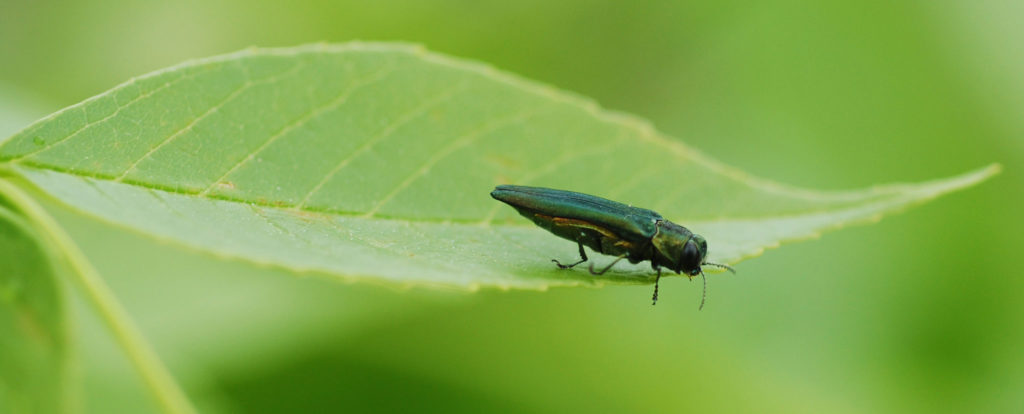With a new spring season in bloom in Colorado, trees are emerging from their winter dormancy period to bring life, color and vibrancy to our communities. Trees, however, are not the only living things completing their overwintering period this spring.
Under the bark of ash trees along the northern Front Range, the larvae of emerald ash borer (EAB) are transforming into adult beetles that will emerge in May and June to infest new trees. First detected in Colorado in 2013 in the City of Boulder, EAB has spread to other cities and towns, with new detections last year in Arvada, Louisville and north of Fort Collins in Larimer County.
EAB is on the move along the Front Range, and with Emerald Ash Borer Awareness Week taking place this week, partners with the Colorado Emerald Ash Borer Response Team are encouraging residents to prepare for EAB and ‘plant ahead’ for the inevitable.
“Spring is an ideal time to plant trees in your yard or elsewhere in your community,” said Dana Coelho, Urban and Community Forestry Program Manager for the Colorado State Forest Service. “If you have an ash tree, consider planting a different tree now – but not another ash tree – to eventually replace that ash. It will take years for your new tree to reach maturity, so get it established now before EAB takes out your ash tree.”

Click here to download a high-resolution image.
With ash trees estimated to comprise 15 percent or more of all community trees in Colorado, EAB poses a serious threat to urban forests. Coelho advises residents on the Front Range to determine if they have ash trees on their property. If they are not sure if a tree is an ash, they should contact their local CSU Extension horticulture agent or a certified arborist who can accurately identify the tree and help them set a plan for it, such as removing and replacing it or treating it for EAB. The CSFS offers tips on selecting a tree care company to assist with EAB.
Coelho also said it is important for residents to plant a variety of trees on their property and in their neighborhoods to increase species diversity. “No one species should comprise more than 10 percent of the planted trees growing in any community setting,” she said. “That way, our urban forests are more resilient to diseases and insects like the emerald ash borer.”
Colorado residents, especially those living on the Front Range, are advised NOT to plant ash trees. The Colorado Tree Coalition offers online descriptions of trees suitable to plant throughout Colorado, plus a list of recommended trees to plant along the Front Range, at www.coloradotrees.org.
EAB Tips for Front Range Residents
- Determine now if you have any ash trees. Identifying features of ash trees include compound leaves with 5 to 9 leaflets; leaflets, buds and branches growing directly opposite from one another; and diamond-shaped bark ridges on mature trees. More information about ash tree identification, including a helpful app, is at csfs.colostate.edu/eab.
- If you have an ash tree, start planning. Decide if the overall health of the tree and the benefits it provides merit current or future treatment, or if it would be best to remove and replace it with a different species. If you are not sure, contact your local CSU Extension horticulture agent or an ISA Certified Arborist. If you do plan to treat the tree, the CSFS offers recommendations for selecting a tree care company.
- Plant trees. Replace ash trees in poor health with diverse species. The Colorado Department of Agriculture offers a database of registered nurseries and landscape contractors.
- Recognize signs of EAB infestation. Property owners with ash trees should be on the lookout for thinning of leaves in the upper tree canopy, 1/8-inch D-shaped holes on the bark and vertical bark splitting with winding S-shaped tunnels underneath. Report suspect trees by calling the Colorado Department of Agriculture at 1-888-248-5535 or filling out their EAB Report Form at https://ag.colorado.gov/eab-identification-and-reporting.
- Help prevent further spread of EAB. Do not transport ash or any hardwood firewood, or any other untreated ash wood products, to other locations outside the Front Range. Dispose of ash wood safely by chipping, composting, milling into lumber or taking to a landfill.
For more information about ash tree identification, the symptoms of EAB, treatment options and how to use ash wood, go to csfs.colostate.edu/eab.
About Emerald Ash Borer and the EAB Response Team
Emerald ash borer (EAB) is a non-native, wood-boring beetle that is responsible for the death or decline of tens of millions of ash trees in the United States and Canada. This insect was first discovered in Michigan in 2002, and since then it has spread to at least 35 states, including Colorado. As a non-native insect, EAB lacks predators in North America to keep it in check. EAB typically only attacks ash trees in the genus Fraxinus, but has also been documented infesting white fringe tree. Mountain ash and other species are not susceptible.
The Colorado EAB Response Team includes members from the following agencies and organizations: Colorado State Forest Service, CSU Extension, Colorado Department of Agriculture, City of Boulder, City of Fort Collins, Davey Resource Group, SavATree, The Keystone Concept, Colorado Tree Coalition, and USDA Forest Service.